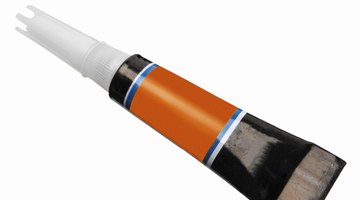How to Remove Super Glue From Marble Counters
Super glue's amazing bonding ability makes it a popular choice for patching broken items. Because of the need for a steady hand when holding the traditionally small tube, people often do their repairs on a table or countertop.

The stable work surface can help reduce your risk of gluing your fingers together, but a drop from the tube could drip onto your counter while you hold pieces together to dry. Super glue dripped on wooden surfaces can be sanded as a last resort, but if you're dealing with a marble surface, you'll need to try another removal method.
Things You Will Need
- Rubber gloves
- Cotton swab or cotton balls
- Acetone
- Credit card, plastic putty knife, or any hard plastic material with a straight edge
- Cloth
Tip
If you plan on using nail polish remover, check the label to see if it contains acetone. Certain polish removers are acetone-free. If the super glue covers a large area, dampen a cloth with acetone and leave it over the glue to soften it. Acetone evaporates quickly, so keep the stain covered continuously to slow the glue from re-hardening while you scrape away certain areas.
Warning
Acetone can damage skin with prolonged exposure. Wear gloves when working with it; otherwise, wash your hands immediately after using it and apply a lotion to replenish moisture to the skin.
-
Put on rubber gloves. Dampen a cotton swab or cotton ball liberally with acetone.
-
Moisten the super glue with the acetone to soften it.
-
Scrape the super glue gently off the countertop with the edge of a credit card or plastic putty knife. Repeat applying the acetone and scraping off the glue until the countertop is smooth.
-
Rinse the area clean with a damp cloth.
The Drip Cap
- Super glue's amazing bonding ability makes it a popular choice for patching broken items.
- Super glue dripped on wooden surfaces can be sanded as a last resort, but if you're dealing with a marble surface, you'll need to try another removal method.
Writer Bio
Jennifer Pinto has been an editor and reporter since 1999, working with newspapers in the Midwest and on the East Coast. She serves as a contributor for several print and online publications, covering business, real estate, religion, home improvement and interior design. Pinto earned her B.A. in English and psychology at Northern Illinois University.
Photo Credits
- George Doyle/Stockbyte/Getty Images
- George Doyle/Stockbyte/Getty Images
More Articles



